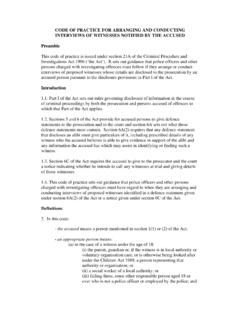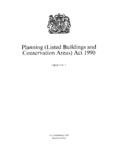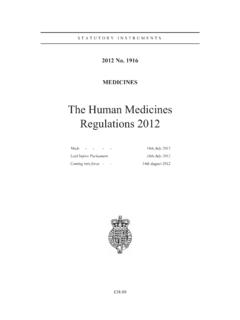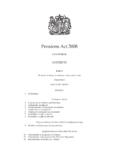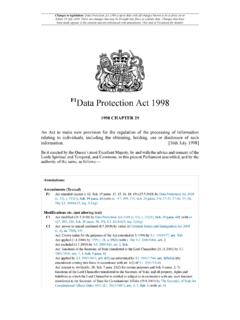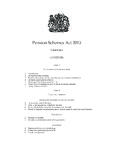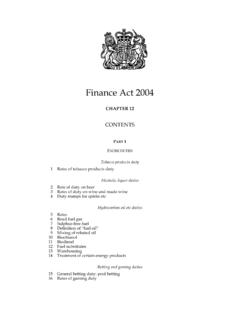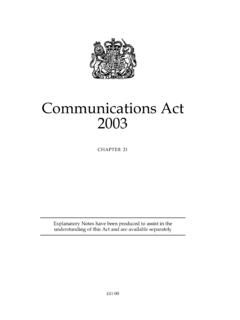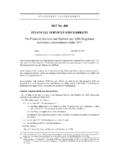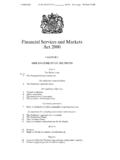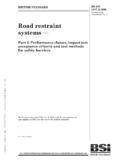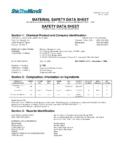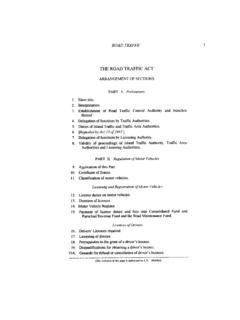Transcription of The Railways and Other Guided Transport Systems (Safety ...
1 STATUTORY INSTRUMENTS2006 No. 599 HEALTH AND SAFETYThe Railways and OtherGuided Transport Systems (Safety ) regulations 2006 Made - - - - -9th March 2006 Laid before Parliament17th March 2006 Coming into forceexcept for regulations19, 23 to 26, 29 and 3410th April 2006regulations 19, 23 to 26,29, and 34 - - -1st October 2006 [DfT 13796] STATUTORY INSTRUMENTS 2006 No. 599 HEALTH AND safety The Railways and Other Guided Transport Systems ( safety ) regulations 2006 Made - - - - 9th March 2006 Laid before Parliament 17th March 2006 Coming into force except for regulations 19, 23 to 26, 29 and 34 10th April 2006 regulations 19, 23 to 26, 29, and 34 1st October 2006 CONTENTS PART 1 INTRODUCTION 1.
2 Citation and commencement 2. Interpretation and application PART 2 safety MANAGEMENT, CERTIFICATION AND AUTHORISATION 3. Use of infrastructure on the mainline railway 4. Use of infrastructure on Other Transport Systems 5. safety management system for the mainline railway 6. safety management system for Other Transport Systems 7. safety certificate 8. Amended safety certificate 9. Further safety certificate 10. safety authorisation 11. Amended safety authorisation 12. Further safety authorisation 13. Notice of changes by holder of a safety certificate or a safety authorisation 14.
3 Direction to apply for an amended safety certificate or safety authorisation 15. Revocation of safety certificate 16. Revocation of safety authorisation 17. General provisions relating to safety certificates and safety authorisations 18. Notification to the European Railway Agency regarding safety certificates and safety authorisations relating to the mainline railway 2 PART 3 GENERAL DUTIES 19. Risk assessment 20. Annual safety reports 21. Sending, issuing, and keeping of documents and making them available for public inspection 22. Co-operation PART 4 safety CRITICAL WORK 23.
4 Interpretation and application of Part 4 24. Competence and fitness 25. Fatigue 26. Co-operation requirements for safety critical work PART 5 MISCELLANEOUS 27. Appeals 28. Offences 29. Transitional provisions and savings 30. Exemptions 31. Defence of due diligence 32. Amendment of ROTS 33. Consequential amendments 34. Revocation SCHEDULE 1 safety MANAGEMENT system SCHEDULE 2 APPLICATION FOR A safety CERTIFICATE PART 1 INFORMATION TO BE INCLUDED FOR A MAINLINE APPLICATION PART 2 INFORMATION TO BE INCLUDED FOR A NON-MAINLINE APPLICATION SCHEDULE 3 COMMON safety INDICATORS SCHEDULE 4 WRITTEN safety VERIFICATION SCHEME REQUIREMENTS SCHEDULE 5 TRANSITIONAL PROVISIONS AND SAVINGS- safety CERTIFICATES AND safety AUTHORISATIONS SCHEDULE 6 CONSEQUENTIAL AMENDMENTS SCHEDULE 7 REVOCATION The Secretary of State.
5 In exercise of the powers conferred upon him by sections 15(1), (2), (3)(a) and (c), (4), (5), (6), 18(2), 43(2) to (6), 47(2), 80, 82(3)(a) of, and paragraphs 1(1)(a) and (c), 31(2), 4(1), 6, 7, 8(1), 9, 14, 15(1), 16, 18(a) and 20 of Schedule 3 to, the Health and safety at Work etc. Act 1974(a) ( the 1974 Act ) (a) for the purpose of giving effect without modifications to proposals submitted to him by the Health and safety Commission under section 11(2)(d) of the 1974 Act after the carrying out by the said Commission of consultations in accordance with section 50(3) of that Act.
6 And (b) it appearing to him that the modifications in paragraph 4 of Schedule 6 are expedient and it also appearing to him not to be appropriate to consult bodies in respect of such modifications in accordance with section 80(4) of the 1974 Act, hereby makes the following regulations : PART 1 INTRODUCTION Citation and commencement 1. These regulations may be cited as the Railways and Other Guided Transport Systems ( safety ) regulations 2006 and shall come into force (a) as respects all regulations except for regulations 19, 23 to 26, 29, and 34 on 10th April 2006 ; and (b) as respects regulations 19, 23 to 26, 29 and 34 on 1st October 2006 .
7 Interpretation and application 2. (1) In these regulations building operation means the (a) construction, structural alteration, repair or maintenance of a building and maintenance shall include repointing, redecoration and external cleaning of the structure; (b) demolition of a building; or (c) preparation for and laying the foundation of an intended building, but does not include any operation which is a work of engineering construction; bus means a motor vehicle which is designed or adapted to travel along roads and to carry more than eight passengers but which is not a tramcar; cableway installation means an installation made up of several components that (a) is used or intended to be used for the purpose of providing an operational system for carrying persons in vehicles, on chairs or by towing devices; (b) uses cables positioned along the line of travel to provide suspension or traction or both; and (c) is one of the following (a) 1974.
8 Sections 15 and 50 were amended by the Employment Protection Act 1975 ( ), section 116 and Schedule 15, paragraphs 6 and 16 respectively; the general purposes of Part I referred to in section 15(1) were extended by section 117 of the Railways Act 1993 ; section 15(1) was amended by 2002/794, article 5(2) and Schedule 2; section 43(3) was amended by the Employment Protection Act 1975, Sections 116 and 125(3) and Schedule 15, paragraph 12 and Schedule 18; section 43(6) was substituted by the Employment Protection Act 1975, section 116 and Schedule 15, paragraph 12; Section 43(6) was amended by 2002/794, article 5(2) and Schedule 2; Sections 80(4) and (5) were substituted for subsections (4) to (6) as originally enacted by the Employment Protection Act 1975, section 116 and Schedule 15, paragraph 19; section 80(4) was amended by 2002/794, article 5(2) and Schedule 2; there are amendments to the Act not relevant to these regulations .
9 4(i) cable car (including a gondola and chair lift) where the cabins or chairs are lifted or displaced by one or more carrier cables; (ii) drag lift, where users with appropriate equipment are dragged by means of a cable; or (iii) funicular railway or Other installation with vehicles mounted on wheels or on Other suspension devices where traction is provided by one or more cables; but does not include cable operated tramways, rack Railways or lifts; carriageway has the same meaning as in the Highways Act 1980(a), or in Scotland the Roads (Scotland) Act 1984(b); common safety methods ( CSMs ) means the methods, developed pursuant to article 6 of the Directive, to describe how (a) safety levels; (b) achievement of safety targets; and (c) compliance with Other safety requirements, are assessed, as revised and reissued from time to time.
10 Common safety targets ( CSTs ) means the safety levels, developed pursuant to article 7 of the Directive, that must be reached by (a) different parts of the mainline railway system ; and (b) that system as a whole, expressed in risk acceptance criteria, as revised and reissued from time to time; competent person means, except for the purposes of Part 4, a person who (a) has sufficient skills, knowledge, experience and resources to undertake the safety verification in relation to which he is appointed; (b) has not borne such responsibility in relation to any of the matters he has to consider in undertaking that safety verification that might compromise his objectivity; and (c) is sufficiently independent of a management system , or a part thereof, which has borne responsibility for any of the matters he has to consider in undertaking the safety verification, to ensure that he will be objective in carrying out the safety verification for which he is appointed.
